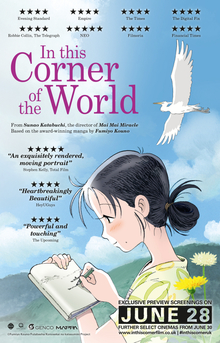
In This Corner of the World is a wildly successful and highly praised animated film. It’s so well liked that it’s difficult to find anyone saying anything bad about it. In this era of computer graphics, its traditional hand drawn animation also gives it plenty of retro charm. I even like its premise of depicting a civilian perspective of the Second World War. However it’s pro-Japanese bias is evident and I am uncomfortable that so many international critics have let its politics pass without remark.
Suzu is a ditzy girl who grows up in a seaside town outside of Hiroshima with parents who make a modest living cultivating edible seaweed. Artistically inclined, she has a tendency to lose herself in daydreams and finds happiness in ordinary things. At the age of 18, she is wooed by a young man who lives in Kure City and moves there to stay with his family. Though the war is already in progress at this time, it makes little impact on her life, save that she can see Japanese warships in the harbor and cheers for them. Later when the rationing gets worse Suzu happily puts up with it, looking for herbs to supplement their food supplies and experimenting with unusual recipes to make what they have taste better. However when the Americans start bombing Japan’s cities and they have to regularly retreat to their bomb shelter, the horrors of war pierces through even Suzu’s innocence. As we all know our history, it isn’t a spoiler to say the film’s reaches its climactic peak with the atomic bombing of Hiroshima and the scene is every bit as horrifying and powerful as you might expect.
There is no doubt that on every level, this is a fantastically produced, beautiful film. Director Sunao Katabuchi did a great job here but I think most of the credit ought to go to Fumiyo Kōno, the creator of the manga upon which this is based. The character of Suzu is perfectly geared to elicit the maximum amount of sympathy and her penchant for daydreaming allows the author to add a small dose of artistic ambiguity to Suzu’s stories as we wonder how much of it is real and how much comes from her imagination. It helps also that Suzu is the type of character who tries to see the silver lining amidst all of the suffering. as we can see when she enjoys even the leftover food given by the American occupiers, though that too falls in line with the sentimental nature of Japanese animated films. I do like that when the worst happens, even the happy-go-lucky Suzu breaks down as her mind is momentarily unable to cope with the horror. As I’ve noted several times before, in order to make the audience feel truly sad on behalf of a character we need to see a previously contented life being torn apart. It is impossible to watch this film and not empathize with Suzu and the other civilians around her.
At the same time, this is a film that unashamedly portrays Japan solely as a victim of the war. Suzu’s father works at the naval arsenal and I understand that to mean that he is actively involved in the making and improvement of weapons of war. The characters cheer when they spot Japanese warships in the harbour and on display once again is the quasi-religious reverence they hold for the Yamato battleship. The worst part is when Japan surrenders. Suzu is devastated and angry that Japan has given in to violence and wants to fight on. I suppose that this is a realistic portrayal of what the civilians thought and felt at the time but the wider truth is that they were either misled by their government or willfully ignorant. It seems incredibly irresponsible to make a film today that only presents this point of view and is silent on the suffering of civilians elsewhere due to Japanese aggression. At the very least, some sort of explanatory foreword seems called for but there’s nothing. It makes me feel uncomfortable that this film is so well liked. A Hollywood film that evinces a political opinion similar to this one would have been deservedly pilloried on the international circuit yet Japan keeps getting away with this.
In This Corner of the World remains invaluable for showing the civilian experience of war but its exclusive focus on Japanese suffering and lack of remorse for the harm inflicted by the Japanese to civilians elsewhere makes it impossible to like it without reservation. This matters hugely when you consider how popular this film is in Japan and how it would influence the thinking of the millions of Japanese who have watched it.